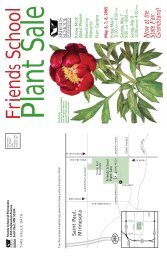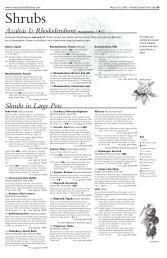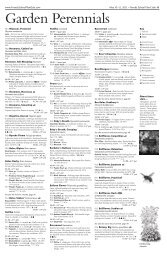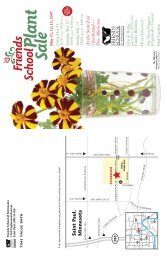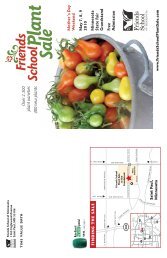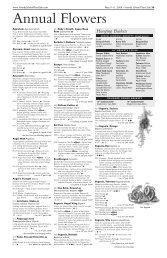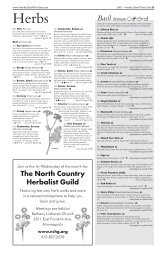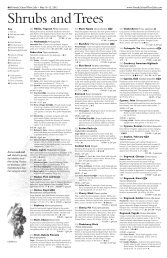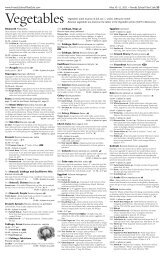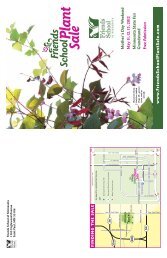View the 2013 56-page PDF here - Friends School Plant Sale
View the 2013 56-page PDF here - Friends School Plant Sale
View the 2013 56-page PDF here - Friends School Plant Sale
You also want an ePaper? Increase the reach of your titles
YUMPU automatically turns print PDFs into web optimized ePapers that Google loves.
www.<strong>Friends</strong><strong>School</strong><strong>Plant</strong><strong>Sale</strong>.com May 10–12, <strong>2013</strong> • <strong>Friends</strong> <strong>School</strong> <strong>Plant</strong> <strong>Sale</strong> 25<br />
Vegetables<br />
Vegetables want to grow in full sun Í unless o<strong>the</strong>rwise noted.<br />
Bareroot vegetables are found on <strong>the</strong> tables in <strong>the</strong> Vegetable section (NOT in Bareroots).<br />
V146 Shallots Allium ascalonicum<br />
A connoisseur’s onion with gentle flavor. Multiple plants<br />
per pot; separate when planting. $1.50—3.5” pot<br />
V147 Sunchoke Helianthus tuberosus ß<br />
Stampede—Harvest edible tubers in spring or fall;<br />
cook or roast like potatoes or eat raw for <strong>the</strong>ir crunchy<br />
sweetness. Bright yellow daisy flowers in late summer<br />
smell like chocolate. Perennial that will spread, so<br />
plant in an area w<strong>here</strong> it is contained unless you plan<br />
to harvest it heavily. Great on <strong>the</strong> alley side of a garage.<br />
96–120”h ∫Ω˜<br />
$3.00—3.5” pot<br />
V148 Sweet Potato ß<br />
Ipomoea batatas<br />
Beauregard—Yummy mashed or baked. Good for<br />
nor<strong>the</strong>rn growing, but wait until <strong>the</strong> soil is fully warm<br />
to plant in June or early July. Keep <strong>the</strong> plants warm in<br />
<strong>the</strong> meantime! You can plant as is, but it’s best to take<br />
slips from <strong>the</strong> plant and stick directly into <strong>the</strong> ground,<br />
keeping <strong>the</strong> soil very moist for <strong>the</strong> first week or so.<br />
A new plant will grow from each node planted.<br />
Copper-colored, inside and out. Needs a warm location.<br />
100 days. †<br />
$2.00—3.5” pot<br />
Tomatillo Physalis<br />
Round fruits with a papery husk; remove <strong>the</strong> husk<br />
before eating. Vining plants, easy to grow. Sweet-tart<br />
flavor great in salsas and sauces. †<br />
$1.50—3.5” pot:<br />
V149 Purple, P. ixocarpa ß—Slightly smaller and<br />
sweeter than green tomatillos. Makes beautiful<br />
purple salsa and is great grilled. Grow more than<br />
one plant for good pollination. Fruit 90 days from<br />
transplant.<br />
V150 Tomate Verde (green), P. lanatus ß—75 days.<br />
$2.00—3.5” pot:<br />
V151 Giant Yellow, P. ixocarpa ◊ß—Large, mildflavored<br />
juicy pale yellow fruit. Good producer.<br />
Excellent for salsa verde. 70 days.<br />
Sweet Peppers Capsicum annuum ͆<br />
$1.50—3.5” pot:<br />
V112 Aconcagua ß—Very large, long frying<br />
peppers, up to 11” by 2.5”. Tall plants<br />
give good yields over a long season, and<br />
<strong>the</strong> fruit is sweet and delicious. This<br />
pepper was named after <strong>the</strong> tallest<br />
mountain in <strong>the</strong> Western Hemisp<strong>here</strong>,<br />
located in Argentina. Great for grilling<br />
as well as general use.<br />
V113 Chocolate Beauty ß—Ripens to a<br />
rich brown color.<br />
V114 Golden Summer ß—Golden, bell<br />
shaped fruits. F1 hybrid, 72 days.<br />
V115 Gypsy ß—Sweet 3–4” peppers, recommended<br />
for cooler climates like ours.<br />
Fruit matures from light yellow to<br />
orange to red. F1 hybrid, 58 days.<br />
V116 Lady Bell larger pot ß—Sweet green<br />
maturing to red bell pepper. F1 hybrid,<br />
72 days.<br />
V117 Purple Beauty ß—Blocky, 3” by 3”<br />
emerald-green peppers that mature to<br />
eggplant-purple with thick, crunchy<br />
walls. 70–75 days.<br />
V118 Takii Ace ß—An early red Japanese<br />
selection recommended for its excellent<br />
yields and flavor. Small to medium<br />
sized fruits, changing from green to red.<br />
A favorite for our region. Flavor is<br />
sweet and delicious. 50 days.<br />
V119 Valencia ß—Large green fruits ripening<br />
to orange.<br />
$2.00—3.5” pot:<br />
V121 Jimmy Nardello ß—Brought to <strong>the</strong><br />
USA by Guiseppe Nardello from <strong>the</strong><br />
small village of Ruoti in <strong>the</strong> Basilicata<br />
region of sou<strong>the</strong>rn Italy. “One of <strong>the</strong><br />
best sweet peppers you will ever taste.”<br />
Long thin gnarly peppers ripen bright<br />
red. Productive, low growing plants,<br />
24”. 80–90 days.<br />
V122 Lipstick ◊ß—Pimiento-type peppers<br />
with sweet green tapered fruits<br />
ripening to a glossy red. Medium thick<br />
juicy flesh. Pick fruits ei<strong>the</strong>r green or<br />
red. Heavy producer even in a cool summer<br />
season. 53–70 days.<br />
Mini Bells—Compact plants fit nicely into<br />
small garden spaces or patio planters.<br />
The peppers are 1.5” long. 60 days 16”h<br />
V123 Chocolate ß<br />
V124 Red ß<br />
V125 Yellow ß<br />
V126 Purple Marconi ß—A deep purple<br />
Italian heirloom with a mild, sweet flavor.<br />
Ripens to a deep wine red. Good<br />
producer. Tapered 6” fruit. Traditionally<br />
used for frying, Marconis are also wonderful<br />
when eaten fresh so try some in<br />
a salad.<br />
72 days.<br />
V127 Sweet Banana ß—65 days,<br />
pale yellow to orange. Ø<br />
A rainbow of colors and range of shapes,<br />
including heirlooms and hybrids.<br />
$2.00—4 plants in a pack:<br />
V128 Golden Summer ß—Golden, bell<br />
shaped fruits. F1 hybrid, 72 days.<br />
V129 Golden Treasure ß—Excellent Italian<br />
heirloom variety. Large tapered fruits<br />
are 8–9” long and 2” at <strong>the</strong> shoulder.<br />
Ripens from green to shiny yellow.<br />
Sweet medium-thick flesh and thin<br />
tender skin. 80 days.<br />
V130 Lady Bell ß—Sweet green maturing to<br />
red bell pepper. F1 hybrid, 72 days.<br />
V131 Sheepnose Pimento ß—An Ohio<br />
heirloom. Pumpkin-shaped fruits are 3”<br />
deep and 4” in diameter. Extremely<br />
flavorful, sweet thick juicy flesh. Good<br />
for canning. Will keep in excellent condition<br />
for three to four weeks in <strong>the</strong><br />
refrigerator. Sturdy plants grow up to<br />
24” tall. 70–80 days.<br />
V132 Sweet Banana ß—65 days, pale<br />
yellow to orange.<br />
$4.00—6 plants in a pack:<br />
V133 Mixed Sweet Peppers ß—One each<br />
Purple Beauty, Valencia (orange), Early<br />
Sunsation (yellow), White, Red Knight,<br />
and Sweet Chocolate.<br />
Heirloom Tomatoes Lycopersicon esculentum ͆<br />
These varieties were cultivated by farmers around <strong>the</strong><br />
world decades or centuries ago. All are open-pollinated,<br />
meaning you can save seed from year to year.<br />
Heirloom tomatoes tend to be indeterminate (vining<br />
with fruit ripening over time). A few are determinate<br />
(bushier, with <strong>the</strong> crop ripening all at one time—good<br />
for canning).<br />
V201 Mixed Heirloom Tomatoes Can’t<br />
decide? Get one each of Brandywine, Yellow<br />
Brandywine, Aunt Ruby’s German Green,<br />
and Cherokee Purple. Ø<br />
—four plants in a pack $3.00<br />
$1.50—3.5” pot:<br />
V152 Aunt Ruby’s German Green ß—Some say <strong>the</strong><br />
best-flavored green tomato. Sweet, yet spicy,<br />
<strong>the</strong>se large, beefsteak tomatoes ripen to a pale<br />
green with a hint of yellow. Indeterminate, 80<br />
days.<br />
V153 Big Rainbow ß—Large yellow and red bicolored<br />
beefsteak tomato. Fruit can be 2 pounds each.<br />
80–90 days.<br />
V154 Bonny Best ß—Medium-sized red tomato,<br />
resistant to cracking; few seeds. Good for canning<br />
and slicing. 72–75 days.<br />
V155 Cherokee Purple ß—This Tennessee heirloom<br />
is extremely productive and has a very rich tomato<br />
flavor. Vines produce a large number of medium<br />
sized, 10–12 ounce fruits. The flesh is a<br />
unique brick red with a rose/purple skin. 80 days.<br />
V1<strong>56</strong> Costoluto Genovese ß—Large, heavily ridged<br />
and lobed, deep-red Italian tomato with a wonderfully<br />
complex flavor that is delicious raw or<br />
cooked down into a rich, hearty sauce. Great for<br />
stuffing. 78 days.<br />
V157 Dester’s Amish ß—Large red-pink beefsteaks,<br />
16 to 24 ounces, full sweet flavor. Very smooth<br />
with good crack resistance. Winner of <strong>the</strong> 2011<br />
Seed Savers Exchange Tomato Tasting. 80–90<br />
days.<br />
V158 Garden Peach ß—100-year-old heirloom. Small,<br />
two-ounce fruits are blush pink when ripe and<br />
look more like apricots than peaches. Sweet, prolific<br />
and stores well in autumn for winter ripening<br />
indoors. 71 days.<br />
V159 Gardener’s Delight ß—Sweet 1.25” cherry red<br />
tomato from Germany. 55–68 days.<br />
V160 Glacier ß—Very early red-orange medium-sized<br />
tomato; more cold tolerant. Determinate, 55–65<br />
days.<br />
Tomatoes need to grow in full sun; <strong>the</strong>y are tropical plants that would prefer<br />
a sunny windowsill, coldframe or indoor growlights until <strong>the</strong> wea<strong>the</strong>r warms up.<br />
$1.50—3.5” pot (continued):<br />
V161 Gold Medal ß—Renamed from Ruby Gold in<br />
1976, this yellow-red bicolor beefsteak with blush<br />
of red on <strong>the</strong> interior is <strong>the</strong> winner of <strong>the</strong> 2008<br />
Seed Savers Exchange Tomato Tasting. 75–85<br />
days.<br />
V162 Hillbilly Potato Leaf ß—Absolutely gorgeous<br />
slicing tomato. Sweet juicy 4–6” flattened fruits<br />
about a pound each are yellow. streaked with red<br />
on <strong>the</strong> blossom end. Heavy producer. 85 days.<br />
V163 Isis Candy Cherry ß—Gorgeous fruits are gold,<br />
marbled with red, each with a starburst on <strong>the</strong><br />
blossom end. Rich flavor is a complex blend of<br />
sweetness and fruitiness. Loads of 1.5” fruits on<br />
short trusses. 70–80 days.<br />
V164 Jaune Flamee ß—Smallish baseball-sized<br />
orange fruits are good for fresh eating and <strong>the</strong><br />
best for roasting. Early and very high yielding.<br />
70 days.<br />
V165 Lemon Drop ß—Translucent yellow-green cherry<br />
tomato with tart-sweet flavor. Winner of <strong>the</strong><br />
2010 Seed Savers Exchange Tomato Tasting.<br />
80–90 days.<br />
V166 Long Keeper, Gold ß—Yellow eight-ounce<br />
fruits with great taste. Pick all <strong>the</strong> fruits before<br />
<strong>the</strong> first frost and store in a cool location without<br />
<strong>the</strong> fruit touching. Will keep up to four months.<br />
76 days.<br />
V167 Mexico Midget ß—Early and very prolific<br />
plants continue producing throughout <strong>the</strong> entire<br />
growing season. Round, half-inch fruits give an<br />
incredible flash of rich tomato flavor, great for<br />
salads. Huong’s favorite. 60–70 days.<br />
V168 Moonglow ß—Medium-sized bright orange<br />
fruits. Solid orange meat, few seeds and wonderful<br />
flavor. Seed Savers taste test winner 2007.<br />
80 days.<br />
V169 Mr. Stripey ß—Large, lightly ridged, vibrantly<br />
colored red-and-yellow striped tomato with a<br />
mild, low acid taste. Indeterminate, 80 days.<br />
V170 Nyagous ß—Baseball-sized black fruits are<br />
borne in clusters of up to six; very productive.<br />
Excellent full flavor. 80 days.<br />
V171 Plum Lemon ß—Collected from an elderly<br />
seedsman at Moscow’s Bird Market during <strong>the</strong><br />
August 1991 coup. The fruit is 3” long with a<br />
pointed end—it really resembles a lemon. Meaty,<br />
sweet refreshing flavor. 72 days.<br />
Bell Pepper<br />
$1.50—3.5” pot (continued):<br />
V172 Principe Borghese ß—Bright red egg-shaped<br />
Italian cherry tomato with an intense tomato flavor<br />
and non-watery flesh that makes it ideal for<br />
drying. Good for containers. Determinate, 75<br />
days.<br />
V173 Red Zebra ß—Huge yield of 2” red fruits with<br />
light yellow striping (or as some say, yellow fruit<br />
with red striping). 80 days.<br />
V174 Silvery Fir Tree ß—Russian variety with distinctive<br />
ferny silvery-gray foliage on compact<br />
plants. Heavy crops of round, slightly flattened<br />
3–3.5” red fruits. Does extremely well in hanging<br />
baskets or on patios. Determinate, 58 days. 24”h<br />
ç<br />
V175 Striped Cavern ß—Gold-striped red fruit with a<br />
bell pepper shape. Thick-walled and hollow with<br />
just a small cluster of seeds: great for stuffed<br />
tomato recipes. Keeps four weeks when harvested<br />
ripe. Good flavor. 80 days.<br />
V176 Striped German ß—Red and gold stripes, interior<br />
marbled. Beautiful sliced. Medium to large<br />
fruit. Smooth texture, good flavor. 78 days.<br />
V177 Stupice ß—Czech heirloom that produces red<br />
2.5” fruits. 55–68 days.<br />
V178 Sweet Pea ß—Looking just like tiny ruby peas,<br />
<strong>the</strong>se are more than a cute novelty. They have an<br />
intense complex sweet flavor that’s great for<br />
snacking and salads. Huge vining productive<br />
plant. 62–75 days.<br />
V179 Velvet Red ß—Silver-gray foliage with 1” red<br />
slightly fuzzy cherry fruits. Winner of <strong>the</strong> 2009<br />
Seed Savers Exchange Tomato Tasting. 75–80<br />
days 72–96”h<br />
$2.00—3.5” pot:<br />
V180 Black Cherry ß—Cherry-sized fruits <strong>the</strong> color<br />
of dark chocolate continue to ripen after light<br />
frost. Flavor is wonderful, very rich and sweet.<br />
Vigorous. 65 days.<br />
V181 Blondkopfchen ß—The name means “little<br />
blonde girl.” Heavy yields of clustered, golden<br />
yellow 1/2” cherry tomatoes. Very sweet.<br />
Sprawling vines. From <strong>the</strong> Gatersleben Seed Bank<br />
in Germany. 75 days.<br />
Heirloom Tomatoes continued on <strong>page</strong> 26<br />
Tomato<br />
Terms<br />
Indeterminate<br />
tomatoes are vining<br />
and tend to ripen<br />
fruit over an extended<br />
period of time. These<br />
are traditionally<br />
staked.<br />
Determinate<br />
tomatoes tend to be<br />
bushier and to ripen<br />
<strong>the</strong>ir crop all at one<br />
time, a feature that<br />
canners and freezers<br />
might note.<br />
Heirlooms are<br />
INDETERMINATE<br />
unless o<strong>the</strong>rwise<br />
noted.





